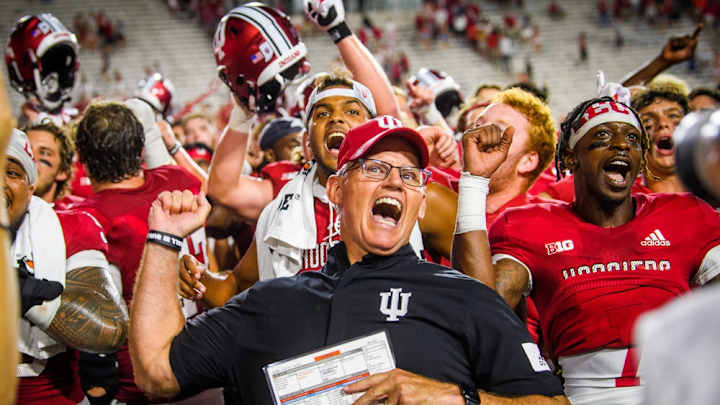Big Ten’s Boldest and Most Embarrassing Schedules Revealed: Why Wisconsin’s Path Deserves Praise While Indiana’s Sparks Outrage Across the Conference
College football scheduling has always walked a tightrope between competitiveness and convenience, and the Big Ten Conference’s recently released 2025 slates have once again thrust that balancing act into the spotlight. But this year’s unveiling has done more than just stir debate—it’s divided the conference into two stark realities. On one hand, you have Wisconsin, a team being handed one of the most brutal, demanding, and respectable schedules in all of college football. On the other hand, there’s Indiana, whose slate of opponents has many fans, analysts, and even rival coaches shaking their heads in disbelief. It’s not just a matter of toughness. It’s a matter of perception, fairness, and what it means to compete in what’s supposed to be one of the premier football conferences in America.
The contrast between the two is hard to ignore and even harder to defend. Wisconsin’s schedule reads like a gauntlet, a relentless trek through high-caliber programs, storied rivalries, and must-win scenarios with national implications. Their opponents are stacked with teams boasting recent playoff appearances, blue-chip recruiting classes, and top-tier coaching talent. They aren’t ducking anyone. They aren’t hiding behind easy wins or scheduling relief. They’re stepping into a warzone with full knowledge of what it takes to emerge as contenders, not just in the Big Ten, but in the College Football Playoff picture.
Meanwhile, Indiana’s schedule appears designed not for contention but survival—and not even the kind that impresses. It’s light. It’s soft. It’s missing the types of opponents that test a program’s mettle and demand respect from the rest of the nation. The gap between what Wisconsin is being asked to do and what Indiana gets to avoid is jaw-dropping. And while some might argue that every team deserves a break once in a while, there’s a point at which the disparity becomes not just a strategic difference but a stain on the conference’s integrity.
The Big Ten, now featuring coast-to-coast power with the additions of USC, UCLA, Oregon, and Washington, is no longer just a Midwestern juggernaut—it’s a national brand. That means the strength of each program’s schedule reflects directly on the conference’s image and its competitive balance. If one team is playing the likes of Ohio State, Penn State, Oregon, and USC while another is skating by with a lineup devoid of top-tier threats, it sends a message that not every path to bowl eligibility—or national relevance—is created equal. And right now, the path Wisconsin is walking looks like a mountain trail, while Indiana is being chauffeured down a paved highway.
The reaction to the schedule release has been swift. Wisconsin fans, while understandably daunted by the task ahead, have embraced the challenge. They understand that iron sharpens iron. That in order to be the best, you have to beat the best. They’re excited to see their team tested on the biggest stages against the most dangerous teams. Every game on their schedule feels like an event, a moment that could define their season and elevate their program. It’s the kind of schedule that draws national attention, sells out stadiums, and builds playoff résumés.
Indiana fans, on the other hand, have found themselves facing criticism not from their own doing but because of what the schedule appears to signal. It’s not the fault of the players or even the current coaching staff. But when the conference hands out a slate that looks more like a mid-major’s non-conference wishlist than a legitimate Big Ten campaign, it draws a line in the sand. It tells recruits, fans, and TV networks alike which programs the conference is investing in—and which ones it might be propping up artificially.
It’s not just about toughness for toughness’ sake. It’s about competitive integrity. When teams like Wisconsin have to earn every inch, every win, every ranking through weeks of intense, physically demanding football, and others get a lighter lift, the scales tip. And in a conference that now aims to compete with the SEC for national dominance, that kind of imbalance becomes a weakness, not a feature. You don’t see Georgia or Alabama getting cupcakes every week. The SEC, for all its flaws, generally ensures that its top-tier programs are tested and battle-hardened. The Big Ten, if it wants to stand shoulder to shoulder with the best, has to do the same.
Wisconsin isn’t asking for pity. They’ve always been a tough, proud program. They’ve thrived on physicality, on grinding out wins in cold weather, on earning national respect through results rather than perception. And in some ways, this schedule plays right into their identity. They’re not looking to coast into November. They want to march into it having beaten teams others are afraid to face. That mindset, that willingness to embrace the challenge, is exactly what separates pretenders from contenders. And it’s what makes Wisconsin’s 2025 slate a source of pride.
The implications of these schedules extend beyond the teams themselves. Media coverage, playoff seeding, strength of schedule metrics, and fan perception all hinge on these decisions. When one program is allowed to accumulate wins against lesser competition, while another is grinding through ranked opponent after ranked opponent, the outcomes no longer tell the full story. That’s a problem. One the Big Ten should be actively trying to solve—not accidentally worsening with unbalanced scheduling.
There’s also the recruiting angle. High school athletes and their families pay close attention to schedules. They want to know where they’ll be challenged, where they’ll get national exposure, and which programs are built to compete at the highest levels. Wisconsin’s schedule says loud and clear: come here if you want to play with the best and against the best. Indiana’s, fairly or not, risks saying the opposite. That’s not just an aesthetic issue—it’s a competitive disadvantage in the long run, even for the teams being protected.
The conference office, likely juggling numerous scheduling conflicts, media obligations, and travel demands with its now-expanded footprint, may not have intended to create such a stark divide. But the result is real, and the perception is powerful. And as Big Ten football heads into a new era defined by expansion, TV contracts, and playoff ambitions, the importance of crafting schedules that uphold competitive standards cannot be overstated.
In the past, Wisconsin has been a model of consistency in the Big Ten. Tough, disciplined, and never afraid of a fight. Their 2025 schedule rewards that tradition with a challenge worthy of their pedigree. They’ll be tested, no doubt. But they’ll also have every opportunity to prove themselves on a national stage. Indiana, meanwhile, has the opposite: a slate that looks more like a damage control plan than a campaign to build greatness.
That disparity doesn’t just hurt the teams involved—it diminishes the competitive reputation of the Big Ten as a whole. Fans and analysts around the country are watching, comparing, and drawing conclusions about the strength of the conference and its fairness. If the Big Ten wants to maintain its credibility and grow its brand, the lesson is simple: every team deserves a fair shot—and every schedule should reflect that.
Wisconsin has theirs. Indiana, this time around, does not. And while one team prepares for a battle every Saturday, the other faces questions that no win column can fully answer. In a sport where the margins are razor-thin and perception shapes reality, that contrast is not just noticeable—it’s unforgettable. The Big Ten should take pride in the tests it gives its best. But it also must take accountability for the passes it hands out to the rest.



